A variety of factors affect climate.
So why is all this climate change happening?
In the past few decades, scientists have discovered that the levels of certain gases in Earth’s atmosphere are on the rise. These gases, called greenhouse gases—which include carbon dioxide, methane, and nitrous oxide— trap heat and help warm Earth, in a process known as the greenhouse effect. To be sure, the greenhouse effect is a good thing: Without it, the average temperature on Earth would be around —18°C (0°F)—that’s about 34°C (60°F) colder than the planet’s current average temperature! But starting in trie 1980s, scientists began to see evidence of an enhanced greenhouse effect, which they have linked to the release of greenhouse gases from burning fossil fuels and other industrial and agricultural practices—in other words, from human activities. INFOGRAPHIC 21.3
THE GREENHOUSE EFFECT
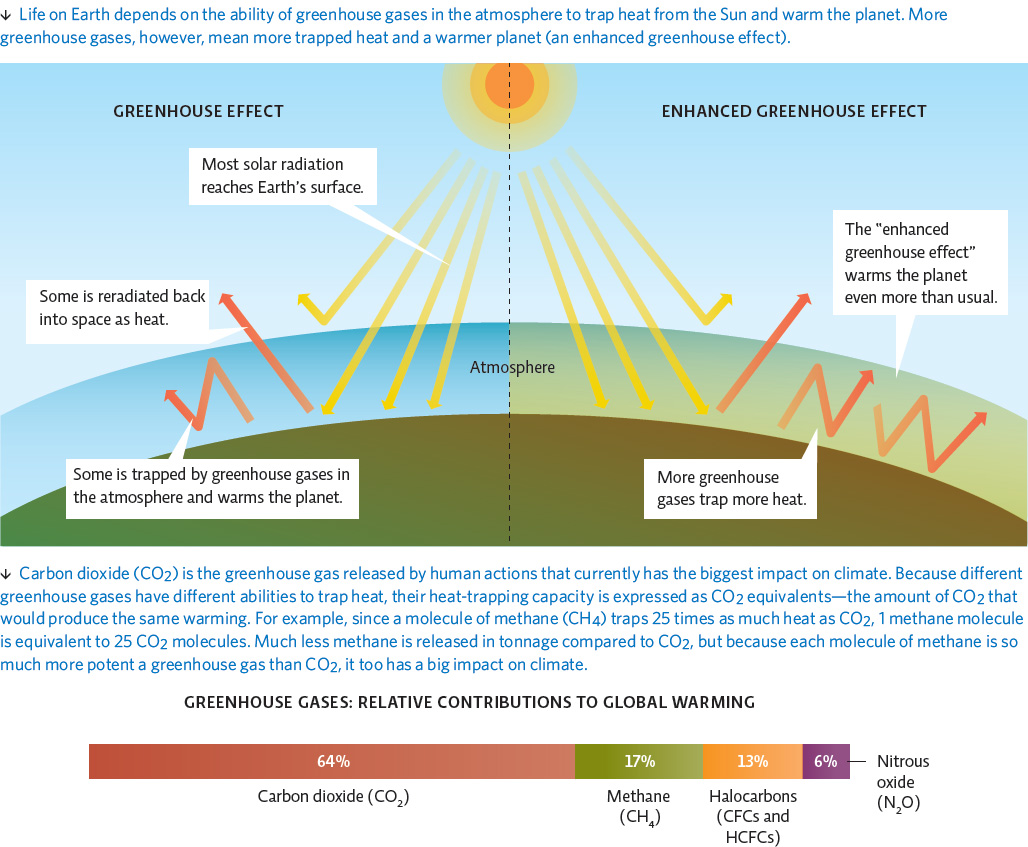

Use the concept of the greenhouse effect to explain how Earth’s surface could warm up even if the Sun’s output does not change.
Gases in the atmosphere trap some of the solar energy that is reradiated from the Earth’s surface, preventing it from being reradiated out to space, thus warming the atmosphere and planet. If more gases are present in the atmosphere, more heat will be trapped, warming the planet’s surface even more.
greenhouse gases
Molecules in the atmosphere that absorb heat and reradiate it back to Earth.
greenhouse effect
The warming of the planet that results when heat is trapped by Earth’s atmosphere.
408
409
410
Greenhouse gases are just one type of radiative forcer, or factor that can affect global climate. Another kind of forcer that plays a role in present warming trends is albedo, the ability of a surface to reflect away solar radiation. Light-colored surfaces, like glaciers and meadows, have a high albedo: They reflect sunlight, and thus heat, away from the planet’s surface. Darker surfaces, like water and dark asphalt, have low albedo: They absorb sunlight, and heat along with it, and then reradiate that heat back to the atmosphere. As surfaces with high albedo are replaced by those with low albedo, not only does the planet warm, but a positive feedback loop can be triggered.
radiative forcer
Anything that alters the balance of incoming solar radiation relative to the amount of heat that escapes out into space.
albedo
The ability of a surface to reflect away solar radiation.
positive feedback loop
Changes caused by an initial event that then accentuate that original event (e.g., a warming trend gets even warmer).
KEY CONCEPT 21.4
Greenhouse gases trap incoming solar radiation and warm the atmosphere. Adding more greenhouse gases enhances this greenhouse effect and warms the planet.
411
Glaciers provide a good example of positive feedback: As temperatures rise, glaciers melt, and ice (with a high albedo) gives way to water (with a low albedo). Because this new watery surface absorbs more heat than the former icy surface, the region warms even faster—replacing even more ice with water. And the cycle continues. INFOGRAPHIC 21.4
ALBEDO CHANGES CAN INCREASE WARMING VIA POSITIVE FEEDBACK
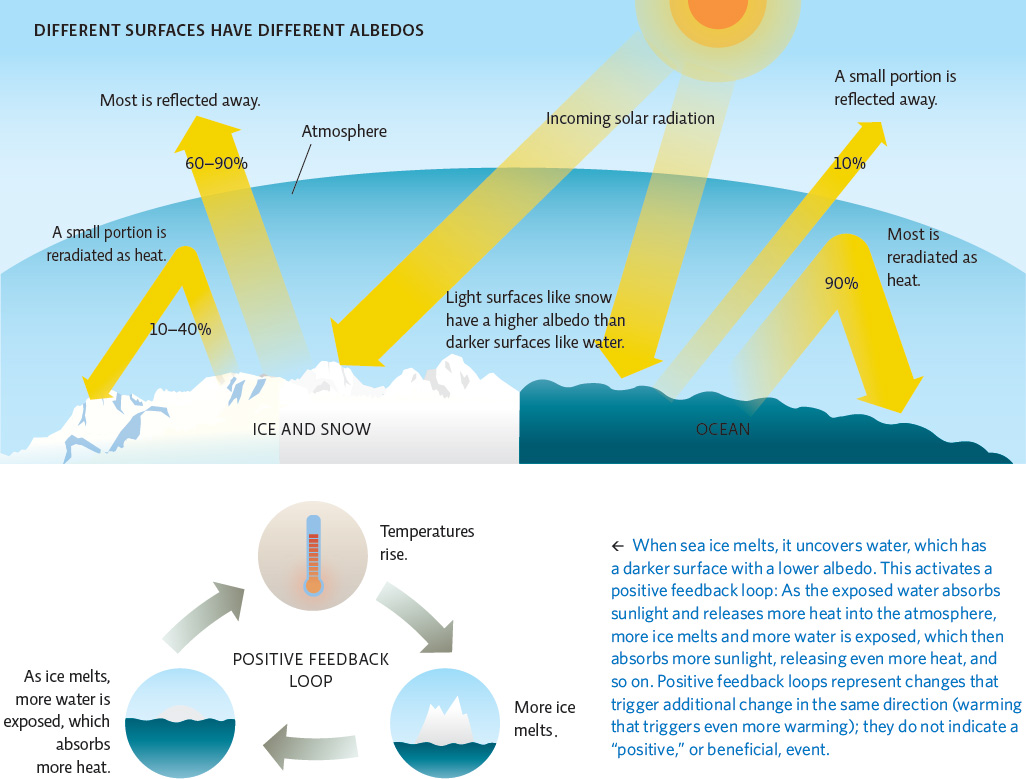

One suggestion to combat global warming is to replace dark rooftops with light-colored ones. How would this help reduce warming?
The light roofs would have a higher albedo than the dark roofs they replace, helping to reflect some solar radiation back out into space rather than absorbing that radiation and reradiating it as heat.
KEY CONCEPT 21.5
The albedo, or reflectivity, of a surface affects surface temperatures and climate. Decreased albedo can increase warming via positive feedback.
There are other positive feedback loops, too. In the Arctic, for example, the upper levels of permafrost (land that normally remains frozen year-round) are melting during the summer months. When these areas thaw, they release stored carbon, adding more greenhouse gases to the atmosphere. These gases warm the area further, causing even more permafrost melt.
412
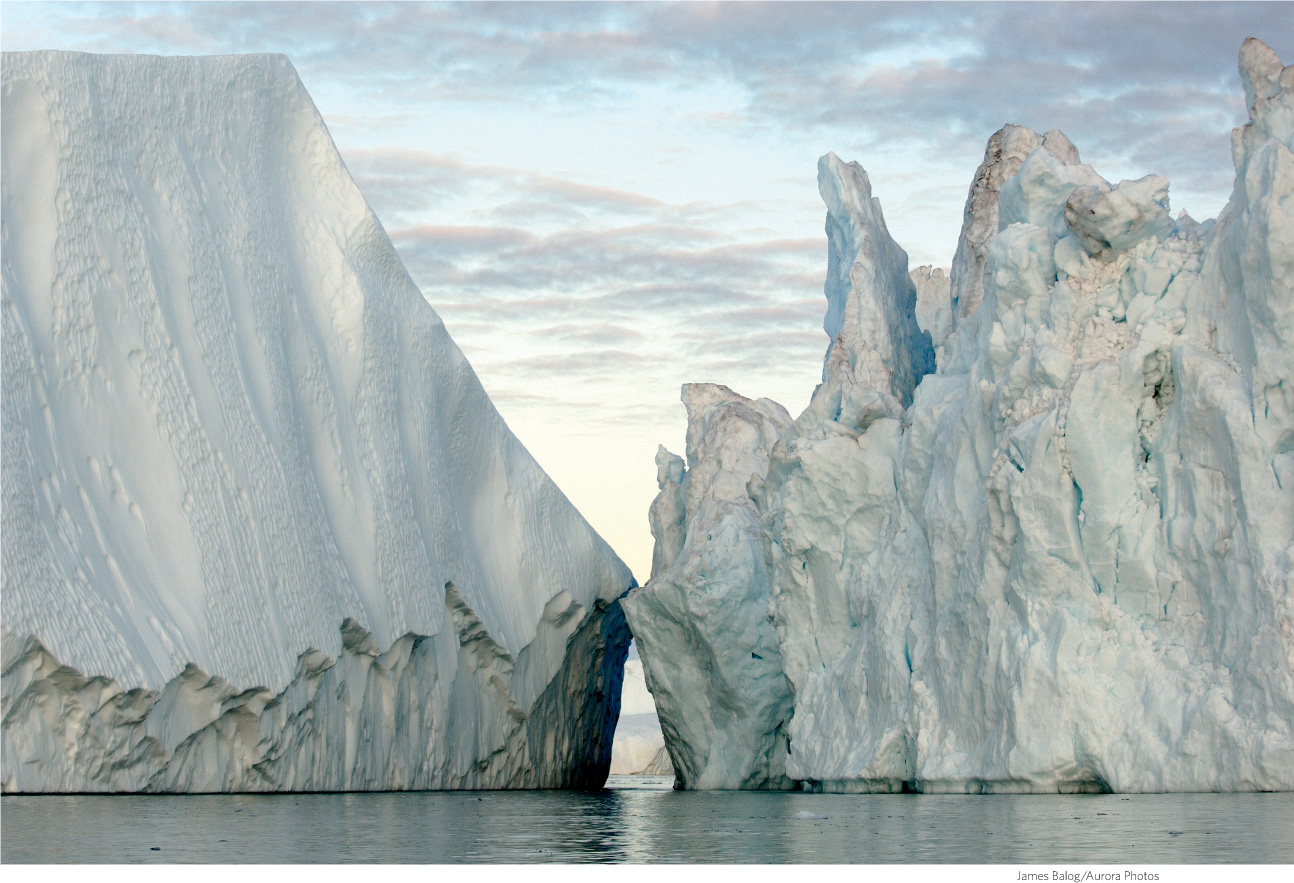
There are also other natural forcers, including clouds. Some have a high albedo and thus work to cool the planet; others trap reradiated heat from the planet’s surface and have a warming effect. If warming temperatures cause the formation of more of the high-albedo clouds, this could trigger cooling—a negative feedback loop. Right now, clouds have a net cooling effect; whether this trend will continue in the future remains to be seen. INFOGRAPHIC 21.5
CLIMATE FORCERS
A variety of factors can warm or cool the planet. Positive forcers have a warming effect; negative forcers cool the climate. Greenhouse gases trap heat in the atmosphere and warm it, while aerosols like sulfate emissions cool it. While there are differences in the confidence that values given for forcers are accurate, it is virtually certain that the anthropogenic forcing is positive rather than negative.
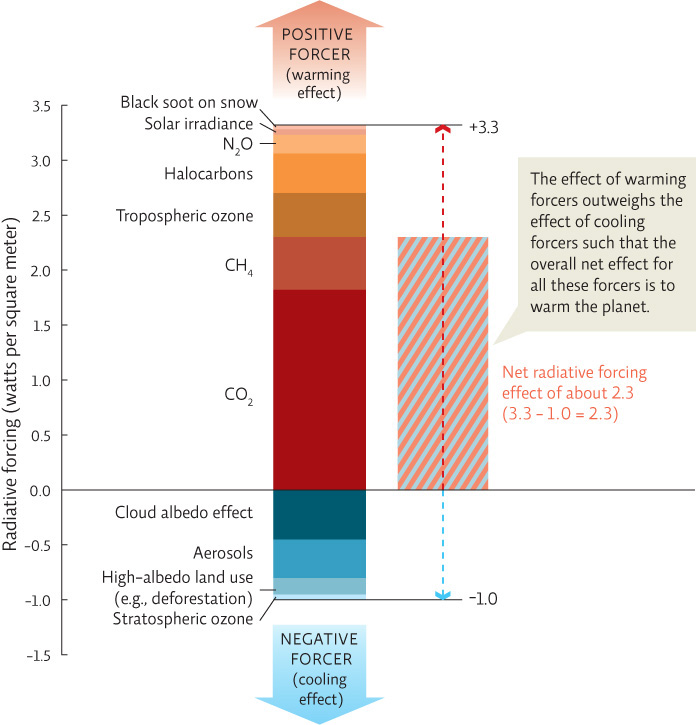

Aerosols like sulfur released from coal power plants are negative forcers. What impact will the efforts to remove sulfur from power plant emissions have on potential warming? Is this a reason to stop our efforts to prevent the release of sulfur? Explain.
As a negative forcer, sulfur helps cool the planet so fewer sulfur emissions would actually increase the potential for warming. But returning to high rates of sulfur release would increase the problems associated with acid deposition and may not be advised since we would be trying to address one problem (climate change) by creating another (acid deposition). There are other ways to decrease positive forcers (reduce greenhouse gas emissions) or increase negative forcers (reforestation efforts) without resorting to a return to problematic sulfur air pollution.
negative feedback loop
Changes caused by an initial event that trigger events that then reverse the response (e.g., warming leads to events that eventually result in cooling).
The oceans play a major role in moderating climate change. While average global atmospheric and surface temperatures climbed steadily beginning in the mid-1970s, around 2003, temperatures began to stabilize, even while atmospheric greenhouse gas concentrations continued to rise. Scientists are finding evidence that much of that “missing heat” may be in the world’s oceans, but there is a limit to how much more heat the oceans can hold, and they could release much of the heat they have sequestered. If it is released, we could be in for a jump in temperature that would continue the previous upward trend.
KEY CONCEPT 21.6
A wide variety of climate forcers can warm or cool the planet. Positive forcers currently outweigh negative forcers, which results in a net warming effect.
413
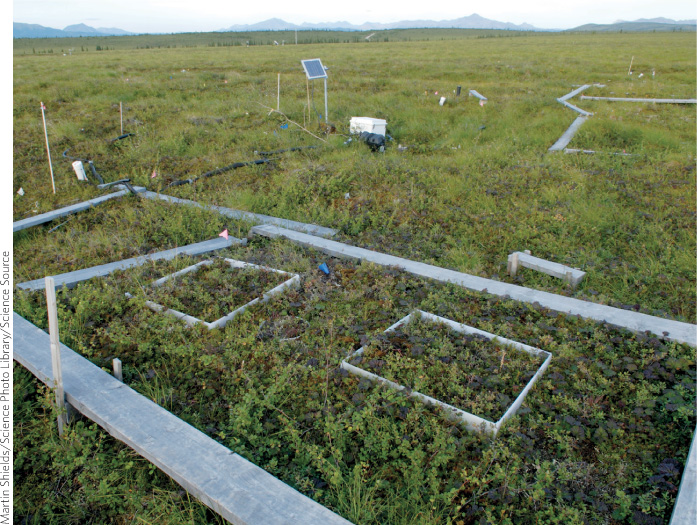
414
Volcanic eruptions and changes in solar irradiance (e.g., sunspot cycles) are also considered natural forcers, as both have been known to impact climate in the past, though only over short time frames and not as severely as greenhouse gases. Scientists also believe that Milankovitch cycles (predictable long-term cycles of Earth’s position relative to the Sun) played an important role in earlier climate change events such as the Pleistocene ice ages. INFOGRAPHIC 21.6
MILANKOVITCH CYCLES HELP EXPLAIN PAST CLIMATE CHANGE
Warm periods and ice ages of the past can be attributed in part to Earth’s position in space relative to the Sun. Earth has three different cycles that can each have an impact on climate. The current warming we are experiencing cannot be explained by any of these cycles—Earth is currently not in a part of any cycle in which it would have greater warming.
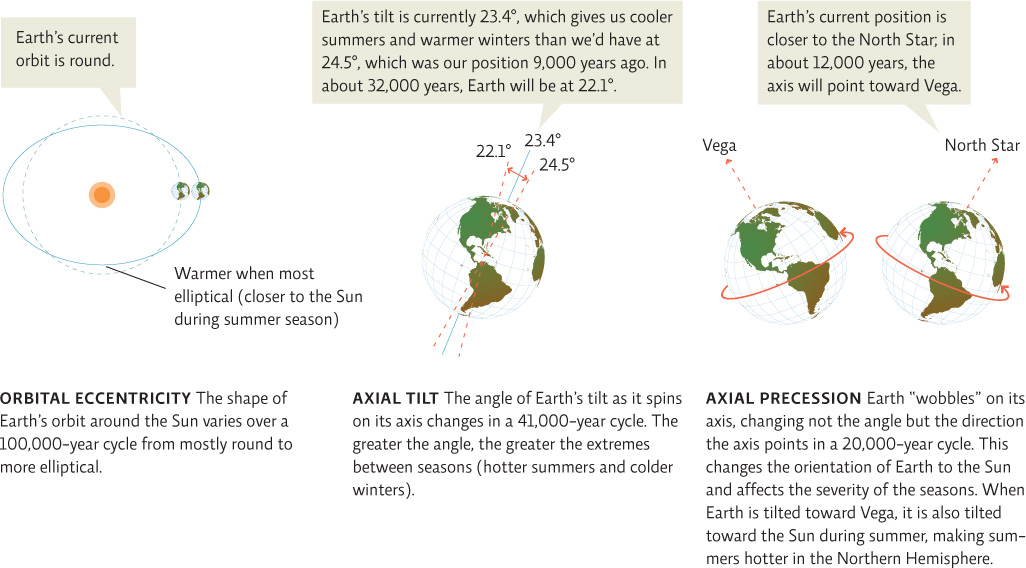

Why do scientists conclude that Earth’s axial tilt is not responsible for our current warming?
Earth's tilt is currently at 23.4° and is moving away from the greater tilt that gave it warmer summers and colder winters 9,000 years ago. If anything, we should be experiencing less extreme weather with cooler summers and warmer winters, rather than the overall warmer temperatures we have been experiencing.
Milankovitch cycles
Predictable variations in Earth’s position in space relative to the Sun that affect climate.
KEY CONCEPT 21.7
Past climate changes are correlated with natural forcers such as the Milankovitch cycles, but these cycles do not account for current warming.
To figure out how much any given forcer or feedback loop is contributing to current warming, or to predict what future climate might look like based on what we are seeing now, climate scientists must do more than monitor current atmospheric conditions; they must also gather data (on temperature, CO2 levels, etc.) from the distant past. They do this by studying a wide variety of clues that have been left behind—ice and sediment cores, tree rings, coral reef growth layers, even fossilized mud at the bottom of lakes and rivers (see Chapter 1). These sources tell us that temperatures and CO2 levels have varied over time and that these two parameters are positively correlated: As one increases or decreases, so does the other. These various sources have consistently corroborated one another: Ice cores paint the same picture as tree rings, and coral reef layers confirm what pollen sediments tell us. This consistency enables us to trust their overall story. INFOGRAPHIC 21.7
DIRECT AND INDIRECT MEASUREMENTS OF TEMPERATURE AND CO2
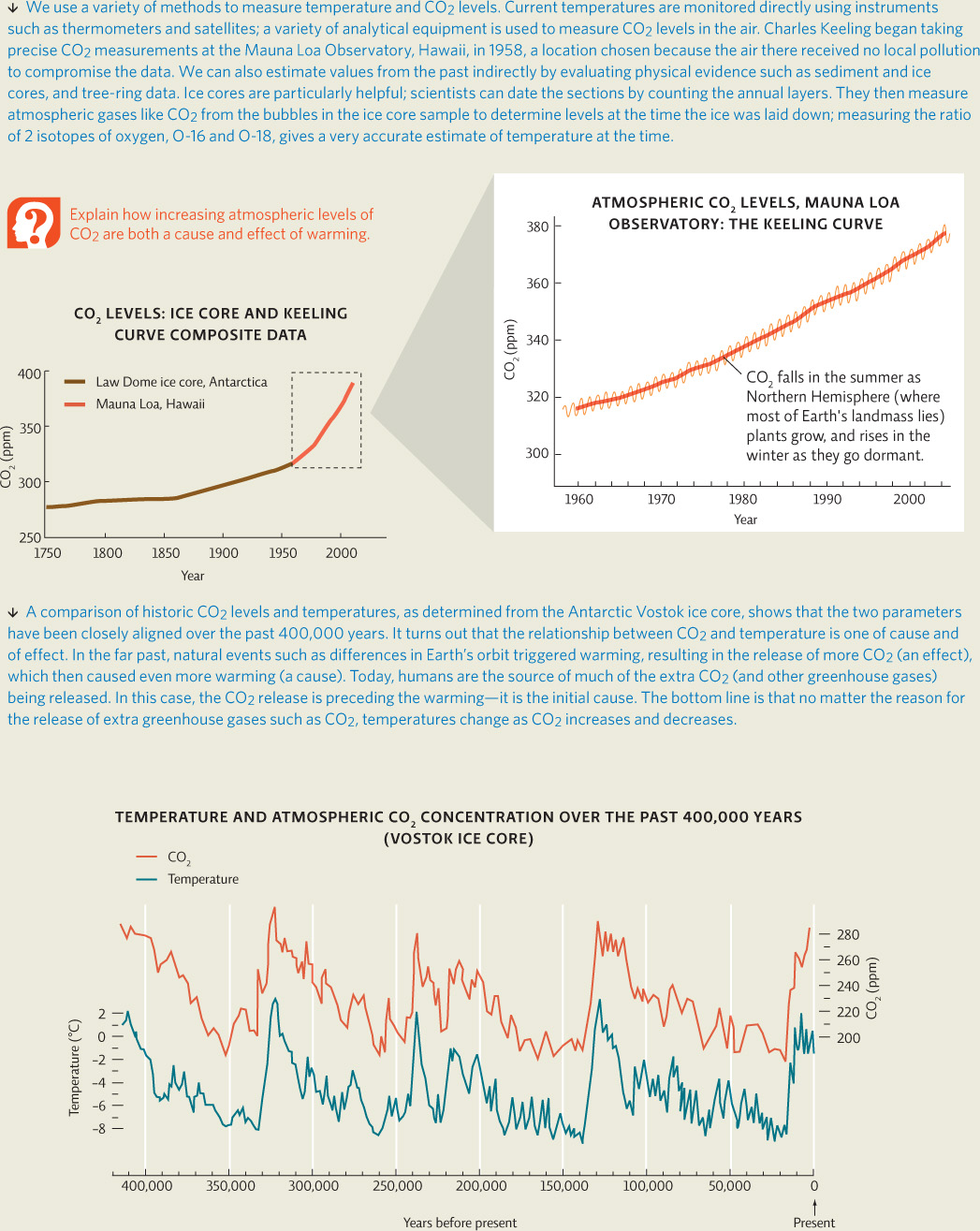

Explain how increasing atmospheric levels of CO2 are both a cause and effect of warming.
Since CO2 is a greenhouse gas, more CO2 can contribute to higher temperatures. But higher temperatures also increase the rate of CO2 release from soil, water, and organisms. These two events can feedback to accentuate each other (more warming leads to more CO2 release which leads to more warming, etc.). Historically, these events would contribute to periods of warming until another factor, such as one of the Milankovitch cycles, reduced incoming solar radiation and dropped temperatures.
KEY CONCEPT 21.8
A variety of methods are used to measure past and present atmospheric CO2 levels and temperatures. All show a positive correlation between CO2 and temperature.
Climate scientists have used this wealth of current and historical data to develop climate models—computer programs that allow them to make future climate projections by plugging in all the current values (for temperature, CO2, global air circulation patterns, etc.). These models are used to see how altering the value of certain parameters (say, increasing the amount of atmospheric CO2) might impact future climate. It may seem ironic that climatologists can predict what the climate will be like 100 years from now, when meteorologists often have a hard time getting the weekly weather forecast right. But scientists say that climate is actually easier to predict than weather. Climate refers to general trends, while weather is much more specific; it is more like a close-up view rather than a view from afar.
415
416